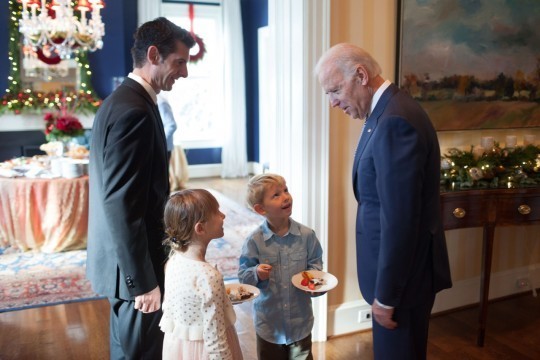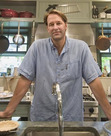Michael Ruhlman's Blog, page 29
March 14, 2014
Friday Cocktail Hour: Pamplemousse Vieux Mot
March 11, 2014
Gratin
March 7, 2014
Friday Cocktail Hour: Bourbon Milk Punch
March 5, 2014
Pan-Fried Chicken Thighs
March 4, 2014
Welcome to the Redesign
Welcome To the Redesign
February 28, 2014
Friday Cocktail Hour: OYO Rye Manhattan

The OYO Manhattan/Photo by iPad
Ohio comes to Manhattan this week for the Friday cocktail hour, which I will enjoy, shivering but happy, on my fire escape in the West Village, with Columbus–based OYO clear rye whiskey, sweet vermouth, bitters, and the indulgent Luxardo maraschino cherries (picked up around the corner at The Meadow (thank you Mark!—check out his book, my favorite salt book, period).
The Manhattan, a classic I never stray far from, a family favorite, and well enduring for a reason (this is one of my favorite Friday Cocktail Hour posts).
The rye Manhattan is especially good when you have great cherries. I add some syrup from the cherries, here not yet dissolved and sleeping at the bottom of the cocktail; rye is marvelously dry as whiskeys go and so the extra sweetness is perfect for this excellent winter cocktail.
Happy Friday, all! Have a great weekend!
OYO Rye Manhattan
2 ounces/60 grams OYO rye whiskey (or any good rye on hand)
1 ounce/30 grams sweet vermouth
5 sturdy shakes bitters (2 grams or so)
1 to 3 Luxardo maraschino cherries (or those candy-like ones in the sundae aisle of your grocery store if that’s all you can find)
Combine the liquids in a lowball, then add ice and cherries.
Stir, sip, take a deep breath, and exhale.
Yield: 1
If you liked this post, check out these other links:
My other cocktails that feature whiskey or rye: my first Rye Old-Fashioned post, Meyer Lemon Fig, and Whiskey Sour.
Learn how to make your own maraschino cherries.
Two James Spirits in Detroit is whipping up their own brand of American rye.
© 2014 Michael Ruhlman. Photo © 2014 Donna Turner-Ruhlman. All rights reserved.
February 26, 2014
Anthony Bourdain on Today’s Chefs

.
A few months ago, in Vegas with Anthony Bourdain and the Parts Unknown crew, I had uncommonly sweet digs and a lot of downtime. Tony probably speaks with more chefs around the world than any other person living. So in between his facial and his pedicure, I talked to him:
M.R.: What issues do you see facing chefs today?
I think a number of chefs are trying to figure out how to be good citizens of the world, and also serve the one percent. Trying to find a balance when their whole business model is built up around expensive markup of bottles of wine, only the very best parts of the fish, the rest has to be disposed of one way or another.
A lot of chefs are trying to reconcile that. Chefs generally are good-hearted people. People like Eric [Ripert], he works closely with hunger relief and they try to do the best they can and try to do the best they can for the best directly as well as give food to City Harvest and places like that.
We’re seeing a lot of chefs go local for a lot of reasons, because it’s the good thing to do to try to keep the money in the area, because it’s hip, because it adds value, people like seeing it on a menu.
It’s better to give your money to an independently operating person in your area than to be giving your money to air freight and someone far away from your area and not feeding money back into it, that’s preferable. I have no problem with people who get the best ingredients they can from all over the world, but I also admire people like Sean Brock, who are in a very real way trying to not just use local, but bring stuff that disappeared locally back, and to restore traditional foodways of the area that fell by the wayside as we entered the land of the tomato that was bred to travel.
You’ve been talking a lot about authenticity. What’s important to you here?
Who owns the food, who owns the recipe? Not intellectual property right. I mean, is it OK for a white guy to cook traditional northern Thai food and make money off it? There is some confusion. Is it OK for Paula Deen to make money off of traditional African American recipes? There’s a discomfort level that’s being discussed now. And I think on both these issues Roy Choi is at the center. As a chef, what are your responsibilities to your family heritage? Do you have a responsibility to preserve the integrity of Grandma’s Korean recipes even if you didn’t grow up in South Korea? You may have grown up next to that food but you may have grown up next to Mexican food or Salvadoran food. To what extent do we need to respect the past, and restore it? Do chefs have any obligation at all to honor the classics?
I’ve always known your love of French classics, a love I share.
There’s a lot to be said for respecting the classics, that maybe you should know how to make a coq au vin the right way, the way by consensus it should generally be made, before you deconstruct it or riff on it. But then again, food has always been in flux, you know? The story of food is the story of invasion, and migration, and oppression. The tomato in curry sauce was not really indigenous to India. Tempura is not indigenous to Japan. It’s always changing. So that’s something people are talking about: What is authentic and do I owe anything to this notion of authenticity at all? People ask David Chang how does he describe his food, he says “tasty food.”
As a sentimental guy, and I think a lot of chefs are sentimental, people feel a certain respect and obligation to do it “the right way,” or at least recognizing the people who came before you and did it for years. I’d hate to see that get lost. No matter how tasty the new stuff is, I’d hate to see the old stuff go. French food, Italian food, Thai food.
I’m fine with any kind of riff, as long as it’s respectful, but even there, is there something wrong with Guy Fieri putting any two ingredients together and giving it a douchey name, and people like it? Probably not. I may find it distasteful, but is it immoral? It may feel immoral to me but I’m probably just being a snob about it.
We see this reverse snobbery now, in order to get the real stuff, you gotta go to some little strip mall on the outer fringes of Los Angeles, some tiny little place where the menus aren’t in English. That’s great but when you look at all the people who are sort of driving American cuisine right now, they’re all Korean American. And they don’t care. They may know what straight-up Korean food is but they sure aren’t cooking it.
And they’re pushing everything forward and they’re having an effect on the non Korean Americans. Eric Ripert is messing around with kimchi—how can that not be good?
Do you see any particularly knuckle-headed trends affecting American chefs?
I’m pretty positive about the way things are going. Even when you see people doing silly food—I overuse the Jimi Hendrix metaphor, but when he became really popular, a lot of people started to play like him, and a lot of them were unsuccessful at it, but it opened them up and they found their own thing. I think a lot of young chefs are making a lot of mistakes and doing a lot of food that they shouldn’t do, particularly in the Modernist cooking area, a lot of people are overreaching. But at the end of the day, when they settle down, they will probably have absorbed a lot of ideas and will apply them in a way that makes their food better. Just because you like Ferran Adrià doesn’t mean you should cook like him, but by the same token, it doesn’t mean a lot of those techniques won’t be standard practice twenty years from now. A lot of them already are. A lot of them will fall by the wayside, but a lot won’t, and we wont think twice about meat glue or agar or spuma.
In Copenhagen, you see all these seafood bars, straight-ahead restaurants, casual eateries, but they’re using the ingredients and techniques they learned at Noma, in sensible ways that make things more delicious.
When you choose to be a chef, what are your obligations, if any?
Increasingly there are obligations. In my generation I don’t think there were, we didn’t think about any obligation. We were in the pleasure business, that was it. Your only obligation was to give your customers a good time at a price point they found reasonable. And you didn’t care where the tomato came from as long as it was a pleasure-giving tomato.
That dynamic has changed. Chefs think about that stuff now. Because the issues are raised and discussed within the community. Because chefs are either being pushed to be citizens of the world or are just naturally thinking about these things from the get-go. These were not issues we thought about back then.
What does sustainability mean to you and is it a real issue for chefs?
It means I’m enjoying serving this now and I’d like to be able to serve it in 25 years. I think even hardcore sushi chefs in Japan are saying, “Look, we have to cut back or there’s going to be no more of this.”
You have to think about that. It is an issue, and it should be an issue that chefs discuss. The extent to which you get on board is up to each individual chef, but again, without making it a mania. There’s always going to be a lot of hypocrisy and silliness, it’s easy to point a finger and say OK, they’re buying local but their refrigeration system alone is blowing a hole in the ozone layer the size of Michigan. They’re doing the best they can, on balance. People who are serious about food, spend a lot of time thinking about food, cooking it, serving it, writing about it, talking about it, they probably know more about the food and where it comes from and the footprint it leaves than they did ten years ago. The more you know about your meal as a chef and an eater, arguably the better. You can’t argue against it, even when it’s silly. Even when it’s awkward or an affectation it’s still on balance arguably good for the world.
Is it time for your pedicure?
It’s time for me to take your money on the pool table, Ruhlman.
Other links you may like:
A few of my recent posts: Vegetable Porn and Dreaming of Gascony.
Bourdain’s guest post: So You Wanna Be a Chef.
Chef profiles on Melissa Kelly, Grant Achatz, and Rene Redzepi.
© 2014 Michael Ruhlman. Photo © 2014 Donna Turner Ruhlman. All rights reserved.
February 24, 2014
Twenty: Cooking with Your Kids

Christopher Freeman, and his kids Tatum and Cash children cooking together/photo by Justin Park-Yanovitch
Christopher Freeman began his adult life, as I did, aspiring to be a novelist, and was exactly as successful at it as I was. For money work, he was an academic book editor, a job he found so personally soul-killing, he turned to his love of food. He’s now not just a cook and caterer in D.C., he’s security-cleared to work in the White House and at other State venues, including all the dinners at our Vice President’s residence. (The Washington Post wrote about him a few years ago.) I was in our capital last month talking schmaltz, and Freeman, in the audience, raised his hand to ask a question not about schmaltz, but rather about Ruhlman’s Twenty. His praise was so genuine and effusive I asked if I could use it to tell others. What I got in return was a guest post that, while it’s extraordinarily self-serving (for me), it increases my pride in the book in thinking that it might encourage or help other parents to teach their kids to cook. I’ve said it often: we change the way America eats by teaching our kids to cook. I believe that our country is a better place when we cook our own food. This is how we do it. —M.R.
by Christopher Freeman
I know how to cook. In my thirteen years as a food industry careerist, caterer, and writer, I’ve come to know an awful lot about gastronomy. I have served the culinary pleasures of two American vice presidents. I have eaten on camera for CNN When it comes to food and cooking, I’m pretty confident in saying I know my stuff.
But when it came to teaching my own two small children (ages 6 and 8) how to cook, I was flummoxed. Talking about cooking with them was simple. We discussed the importance of hand washing. Proper mise en place. The importance of a correctly sharpened knife. But when it came to actually teaching them how to cook, I didn’t know where to begin. Which of my own vast collection of recipes were simple enough for them to master, I wondered. Which flavor profiles suited their young palates? Which ingredients would both reward and forgive?
I was overwhelmed. I didn’t have a clue.
But what I did have, however, was Ruhlman’s Twenty. As far as cookbooks go, it was an epiphany, a revelation. Because Ruhlman’s Twenty not only teaches us what to cook, it teaches us how. Its recipes teach the twenty foundational techniques of cooking that every cook should master. My kids and I started with something simple. We started with French onion soup: four hours of sweating and caramelizing onions. Four hours of being together, as a family, in our own kitchen. It was profound. From there, the following weekend, it was on to braising. We braised brisket. We braised lamb. Egg cookery came next. Culinary horizons were broadened. Triumphs abounded. And with every new recipe they tried, with every new technique now under their little belts, I saw that my two children were “getting” cooking in ways all-too-rare these days. I saw that they were not simply learning how to cook, but that they were forming a relationship with food that will likely inform their culinary choices—as cooks, as eaters—their entire lives.
To my knowledge, there is no other cookbook quite like Ruhlman’s Twenty.
It’s genius.
And it pisses me off.
Because Ruhlman thought of it before I did.
The above is Christopher Freeman with his kids and Vice President Biden (photo by White House photographer David C. Lienemann) . He writes the food blog Manifesto and is active on Twitter as @proletariateats. Many thanks, Christopher, for offering the kind words about my book, but most of all for teaching your kids to cook. —M.R.
Other links you may like:
My past posts on making Brioche (for Addison) and Chocolate Chip Cookie Bowl (for James).
Take a look at the Just For Kids program at Whole Foods.
Table manners are important for young ones to learn when going out to eat.
Pioneer Woman has lots of great tips and recipes for families.
© 2014 Michael Ruhlman. Photo © 2014 Donna Turner Ruhlman. All rights reserved.
February 21, 2014
Events Update & Friday Cocktail Hour: Clover Club

Clover Club. Photo by Donna Turner Ruhlman.
Gearing up for the publication of EGG: A Culinary Exploration of the World’s Most Versatile Ingredient, herewith a fab cocktail that uses egg white for body and nutrition. Clover Club is one of my favorite protein snacks! The recipe below is adapted from the new book, which you can pre-order here (and get a signed chart, which is the real innovation—the egg, imagined).
I’m getting ready for several weeks of travel and lots of events. Follow me on Facebook for the events schedule.
Scroll past the following events to get to the fabulous, the marvelous, the nutritious Friday Cocktail: The Clover Club.
Upcoming:
Town Hall Series: Continuing my exploration of the theme, “America: Too Stupid to Cook,” at the Ohio State Theater.
Monday, February 24, 6:00 pm
Cleveland, Ohio
Ohio Theatre at Playhouse Square
March 6–9
Where I intend to dig the scene, serves some schmaltzy goodness, eat some salumi at Cypress, see my pals at Le Creuset, and I hope grab a meal at Xiao Bao Biscuit!
Charleston, South Carolina
March 15, 9:00 am–12 noon
University of Illinois–Chicago Forum
Appearing with Chef Brian Polcyn (I will be heckling Brian not from the crowd but on stage as he attempts to demo Italian and American hog breakdown), ever in support of our books Charcuterie and Salumi.
Chicago, IL
Monday, March 17, 2:30 pm
Chicago Marriott Downtown
Chicago, IL
Wherein I will wax philosophical on the multi-platformed life (actually try to figure out in front of a lot of people how I manage to keep everything straight without my head exploding—short answer: pork belly and martinis).
Stay tuned for upcoming EGGcellent events in NEW YORK, RALEIGH-DURHAM, SEATTLE, PORTLAND, and SAN FRANCISCO.
Till then, Happy Friday to all!
The Clover Club
This is splendid gin-based cocktail, sweet and sour, flavored and colored with pomegranate syrup and fortified with egg white. Try to get your hands on actual pomegranate syrup, but Rose’s grenadine will suffice it that’s all you can find.
4 ounces gin
1 ounce fresh lemon juice
1 ounce simple syrup
1 ounce grenadine (pomegranate syrup)
1 egg white
Combine all the ingredients in a shaker (or a blender) and shake till the egg white is frothy (or blend for 2 seconds). Add plenty of ice and stir till frosty cold.
Strain into chilled coupes.
Serves 2
If you liked this post, check out these other links:
My recent cocktail posts: the Rusty Nail, the Sawyer, and the Bitter Elder.
A popular line of spirits is making its way out of Door County, Wisconsin—check out Death’s Door Spirits.
Learn how to make your own gin at home.
How to make your own grenadine syrup, by Portland, OR, mixologist Jeffrey Morgenthaler.
© 2014 Michael Ruhlman. Photo © 2014 Donna Turner-Ruhlman. All rights reserved.
Michael Ruhlman's Blog
- Michael Ruhlman's profile
- 354 followers






